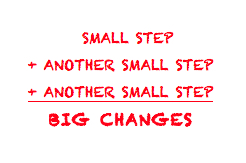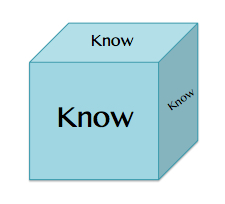By Dr. Jennifer A. McCabe, Goucher College
I recently read James Lang’s (2016) book, Small Teaching: Everyday Lessons from the Science of Learning, which is framed by the premise that incremental shifts in how teachers structure and deliver educational experiences can have a large pay-off in terms of student learning and engagement. Each recommendation is grounded in what we know works for learning from memory research, and each is implementable without significant additional resources, time, or grading. Though Lang does not explicitly frame his book around metacognition (in fact, the word is not mentioned!), much of it supports the development of teacher metacognition with regard to several core components: knowing about (students’) knowing, thinking about (students’) thinking, and learning about (students’) learning.
In this first post (Part I), I describe Small Teaching through a metacognitive lens to support the development of teachers’ metacognition about course design and implementation. In Part II, I will discuss my experience of incorporating this book into a senior seminar in Cognition, Teaching, and Learning.
The first section of Small Teaching, entitled Knowledge, presents the idea that students do not necessarily know what strategies support durable and flexible learning. This gives teachers the opportunity (and responsibility) to structure experiences that support learning, even though these may feel harder, slower, or show smaller gains in the short term (i.e., desirable difficulties; see Yan et al., 2017 for a recent review). The Retrieving chapter discusses the testing effect, and the many ways teachers can encourage students to practice effortful retrieval of information from long-term memory. Predicting presents the value of pre-testing and predictive opportunities, which boost curiosity and aide subsequent learning. Interleaving discusses the spaced (or distributed) study principle, and the related strategy of interleaving (i.e., mixing instead of, or in addition to, blocking); these strategies help rectify the common metacognitive pitfall of forgetting we (and our students) forget. Student’s ability to produce knowledge at one point in time does not necessarily predict their future ability to remember. Incorporating frequent retrieval practice and cumulative assessments are concrete ways to counter-act the natural process of forgetting.
The second section is focused on Understanding, or deep comprehension. In Connecting, Lang discusses strategies to link and expand knowledge, including the intentional activation and use of students’ prior knowledge, use of explicit frameworks (e.g., outlines, concept maps), and writing exercises that support students in the challenging task of creating new connections. Practicing stresses the metacognitive component of knowing about (students’) knowing; that is, intentionally assessing cognitive skills needed for a large assignment, then making space for practice of those skills to scaffold toward successful assignment completion. Self-Explaining describes the strategy of having students explain what they are thinking and doing during a task – another example of a desirable difficulty.
The third and final section of Small Teaching is framed around Inspiration. This includes Motivating, focusing on the role of emotions in learning. Even teachers who have metacognitive knowledge about the basics of learning from a cognitive perspective, may have low awareness of the impact motivation has on learning, and the ways in which we can intentionally utilize students’ emotion (e.g., cultivating positive rapport, showing enthusiasm, using story-telling and narratives, and supporting the development of self-transcendent purpose). Growing helps teachers understand the value of a growth mindset as connected to student success, and how to create classrooms that model and reward growth. Finally, Expanding offers a discussion about “big teaching” – new frontiers for major shifts in how college courses are structured and offered.
Ultimately, the take-away message from Small Teaching is that relatively minor changes can bring big rewards in our classrooms. As an added bonus, many techniques give teachers tangible feedback about how students are progressing toward course learning goals. Viewing this book from a metacognitive framework encourages teachers to examine their own beliefs about learning, which can lead to an enlightening appraisal of why we make the decisions we do. Metacognitive questions abound: What is the learning goal here? How does the structure of this assignment get students to the learning goal? What cognitive processes am I expecting students to engage in (and how do I know they know how to do them)? Does this assignment have an explicitly stated purpose? Do my assessments engage cognitive processes that support durable and flexible learning? Am I being transparent in communicating the rationale for my pedagogical choices to my students? How are my own learning beliefs and biases influencing my students’ experience?
These “small” principles provide great opportunity, but also potential hazards. Teachers need to consider the line between desirable and undesirable difficulties, ensuring that the work we assign for students is difficult in a way that encourages effort in support of learning, and not in a way that overwhelms or otherwise detracts from learning. That is, paying mindful attention to the cognitive processes involved in coursework, and the ability of students to engage in them, is critical. An effective assessment will be challenging in the manner of engaging processes such as retrieval or elaboration that we know support learning. An undesirably difficult assessment will be challenging in a non-productive way. For example, to make students work harder, teachers may give repetitive busy-work that requires time and energy, but does not aid learning. Or consider assessments so difficult that learners do not have the cognitive (or metacognitive) scaffolding in place to engage effectively, even with great effort. Overly difficult assessments can result in feelings of anxiety, overwhelm, and even anger – all of which are counter-productive to learning. Enter the value of teacher metacognition: A teacher skilled in thinking about how learning works, and what their students know (along with skills they bring to the course), will be better able to navigate their assessments to keep them on the side of desirable difficulties.
In sum, metacognitive awareness and self-regulation are both key components to effective translation of memory principles into effective educational design. Lessons from Small Teaching connect to “small” adjustments toward increased metacognitive awareness in teachers. In Part II I will explain and reflect on my, and my students’, experience with Small Teaching in my seminar course.
Recommended Reading
Lang, J. M. (2016). Small Teaching. San Francisco, CA: Jossey-Bass.
Yan, V. X., Clark, C. M., & Bjork, R. A. (2017). Memory and metamemory considerations in the instruction of human beings revisited: Implications for optimizing online learning. In J. C. Horvath, J. Lodge, & J. A. C. Hattie (Eds.), From the Laboratory to the Classroom: Translating the Learning Sciences for Teachers (pp. 61-78). New York: Routledge.

